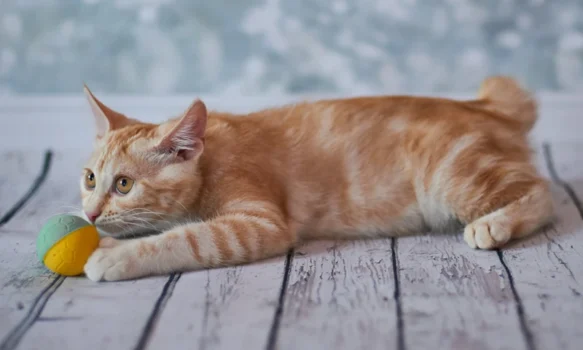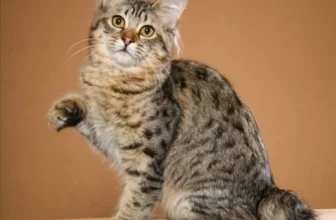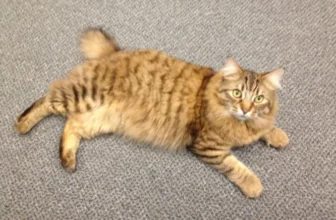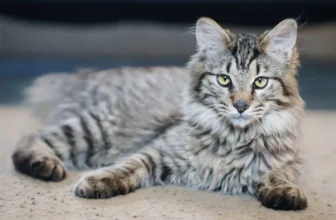As feline enthusiasts, we are in awe of the American Bobtail’s distinctive looks and charming personality. However, these adored cats hold a mysterious past that intrigues us even more. How did these bobtailed cats come to be, and what significant role did they play in ancient societies? In this detailed article, we will explore the origins and evolution of American Bobtails, their significance in ancient cultures, and their journey to the New World. Join us as we unravel the mysterious past of American Bobtails.
Origins and Evolution of American Bobtails
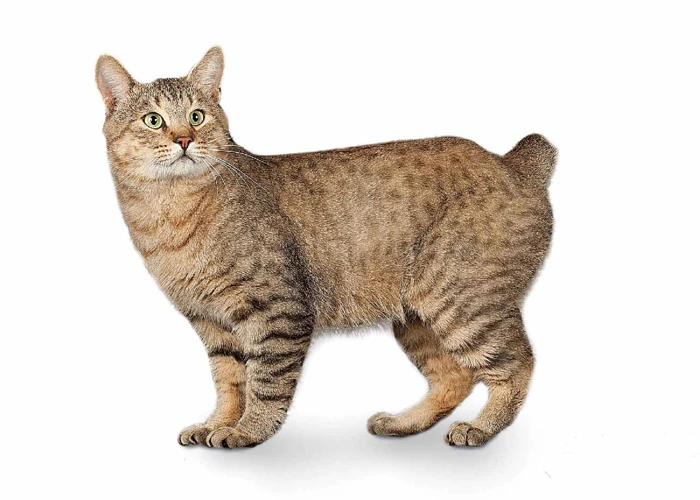
The origins and evolution of American Bobtails are shrouded in mystery and conjecture. While historians and cat lovers alike have attempted to unravel the fascinating history of these felines, their true origins remain a matter of debate. Nevertheless, by examining various theories about where American Bobtails come from and how they evolved over time, we can begin to piece together a picture of these enigmatic cats. Let’s explore the intriguing history of American Bobtails, from their possible origins to their gradual spread across the ancient world and eventual arrival in North America. For those interested in the role of American Bobtails in the Wild West, click on this link.
Theories on the Origins of American Bobtails:
The exact origins of American Bobtails are largely uncertain, and the precise method of their arrival in North America remains a mystery. There are, however, a few theories which have been proposed over the years.
Theory 1: Some believe that American Bobtails were originally a breed of domesticated cat hybridized with a bobcat. According to this belief, the breed’s distinct short tail is a result of a genetic mutation.
Theory 2: Others speculate that American Bobtails came from Southeast Asia – specifically from the coast of the Sea of Japan in Russia – and were brought to North America by way of the Bering Strait land bridge.
Theory 3: A third theory posits that American Bobtails were brought to North America by Spanish conquistadors, who brought them on their ships as a means of vermin control. This theory suggests that the American Bobtail was bred with Spanish and European cats to create the modern breed we know today.
There is no concrete evidence to support any of these theories, and the mystery of the American Bobtail’s origins only adds to their enigmatic allure. To explore more about the role of American Bobtails in the Americas, check out our article about their influence during the American Revolution: The Role of American Bobtails in the American Revolution.
Evolution of American Bobtails:
The evolution of the American Bobtail is a subject of ongoing research and debate. Despite many theories, there is still no consensus among experts on its true origins. However, there is some evidence to suggest that these cats have been around for many centuries.
One theory about the evolution of American Bobtails involves genetic mutations that occurred naturally over time. Studies have shown that some genetic mutations can result in shortened tails in cats. This could explain why American Bobtails have such distinctive tails, as these cats may have been genetically selected for this trait over generations.
Another theory suggests that American Bobtails were bred by early settlers in North America. These settlers may have brought cats with them from their home countries, and over time, these cats interbred with local feral cat populations. This could have led to the development of the American Bobtail.
Regardless of their origins, American Bobtails have remained a popular breed in North America for many years. They are known for their friendly personalities and playful nature, which have made them popular pets for families with children. Additionally, their strong hunting instinct has made them a popular choice as a hunting companion (link to /american-bobtail-hunting-companion/) for many people.
Despite their popularity today, American Bobtails have also played a significant role in history. These cats have been featured in myths, folklore, and pop culture (link to /american-bobtail-myth-folklore/ and /american-bobtail-pop-culture/), and have even been owned by famous individuals, including presidents in the White House (link to /am-bobtails-white-house/) and famous explorers (link to /american-bobtails-famous-explorers/). During World War II, American Bobtails were often kept on naval ships to catch rats and mice, which helped to protect the food supply for soldiers (link to /american-bobtail-world-wars/).
The evolution of the American Bobtail remains a fascinating topic for researchers and cat lovers alike. While much is still unknown about their origins, their enduring popularity and historical significance are a testament to their undeniable appeal.
American Bobtails in Ancient Cultures
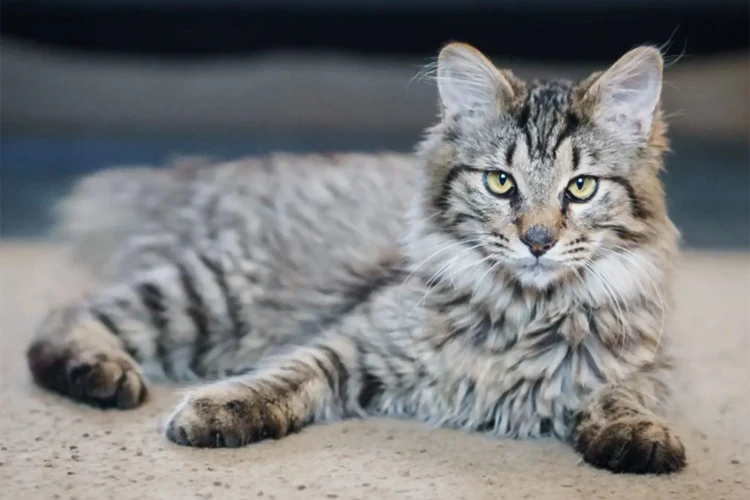
Throughout human history, cats have played a significant role in ancient cultures around the world. Among the feline world, the American Bobtail stands out for its distinctive appearance and unique abilities. Several ancient societies have referenced American Bobtails in their art, literature, and folklore. In this section, we will uncover intriguing details about the relationship between American Bobtails and the ancient cultures they inhabited, exploring their significance in each society.
American Bobtails in Egyptian Culture
American Bobtails have long been associated with ancient cultures, and researchers have uncovered many fascinating insights into their role in ancient Egyptian culture. The relationship between American Bobtails and the ancient Egyptians is thought to have begun around 4,000 years ago, during the Old Kingdom period.
Appearance in Egyptian Art: American Bobtails make a number of appearances in Egyptian art, from paintings to sculptures and even hieroglyphics. In fact, many of the depictions look almost identical to the American Bobtails we see today, with their distinctive short tails and powerful bodies. These artistic representations suggest that American Bobtails held a special place in the hearts of the ancient Egyptians.
Symbolism and Religious Significance: It is believed that American Bobtails were highly regarded by the ancient Egyptians and were seen as symbols of power, grace, and protection. They were closely associated with the goddess Bastet, who was often depicted with the head of a cat. Bastet was the goddess of fertility, love, and music, and was believed to protect women and children. As a result, American Bobtails were often seen as protectors of the home and were highly prized as pets.
Care and Treatment: In ancient Egyptian society, American Bobtails were highly valued and well-cared for. It was not uncommon for them to be given the same care and attention as humans, including lavish diets and medical treatment. They were often treated as members of the family and were given names and respected as individuals.
To this day, American Bobtails are still revered by many, and numerous people have become famous for their ownership of these amazing cats. If you’re interested in learning more about the notable individuals who have owned American Bobtails throughout history, check out our page on famous American Bobtail owners.
American Bobtails in Greek and Roman Cultures
In Ancient Greece and Rome, American Bobtails were highly valued for their impressive hunting skills and loyal companionship. These cats were often depicted in paintings and sculptures, serving as a symbol of strength and agility. They were highly revered by the aristocrats and were given special treatment in the society.
Greek Society: The Ancient Greeks viewed cats as sacred animals and would often portray them in their literature and art. The famous Greek historian Herodotus even praised the cat for saving a Spartan army from starvation by catching and eating mice that were destroying the army’s food supply. American Bobtails were highly respected in Greek society, and it was even believed that they had divine power. There is evidence suggesting that American Bobtails were used in the temple of Artemis in Ephesus for pest control and as protectors of the temple.
Roman Society: Ancient Romans had a similar view of cats and used them for their hunting skills. American Bobtails were highly valued for their ability to catch rodents, making them a valuable asset in any home or establishment. They were even viewed as protectors of the home and would be given as gifts to newlyweds to signify good luck and protection against evil spirits. These cats were also frequently featured on mosaics and frescoes in Roman homes, showcasing their importance and status in society.
American Bobtails had a significant impact on Greek and Roman cultures, serving as symbols of strength, agility, and companionship. They were highly regarded for their hunting skills and were often revered as sacred animals in these societies. Today, American Bobtails continue to be valued for their loyalty and intelligence, making them an excellent choice for any pet owner.
| Aspect | Greek Society | Roman Society |
|---|---|---|
| Cultural significance | American Bobtails were viewed as sacred and were believed to have divine power. They were used in the temple of Artemis in Ephesus for pest control and as protectors of the temple. | American Bobtails were highly valued for their hunting skills and were viewed as protectors of the home. They would be given as gifts to newlyweds to signify good luck and protection against evil spirits. |
| Depiction in art and literature | American Bobtails were often painted and sculpted, serving as a symbol of strength and agility. They were highly revered by the aristocrats and were given special treatment in the society. | These cats were frequently featured on mosaics and frescoes in Roman homes, showcasing their importance and status in society. |
| Usage | American Bobtails were used for pest control and as protectors of the temple in Ephesus. | The cats were highly valued for their hunting skills and were often used for rodent control in homes and establishments. |
American Bobtails in Asian Cultures
Asian cultures have a long history with cats, and American Bobtails have played their part in this history. In Japan, the American Bobtail is known as the “Yamaneko,” which translates to “mountain cat.” These cats were considered good luck and were often given as gifts to promote prosperity and health. They were also believed to have healing powers and to be able to ward off evil spirits. American Bobtails were so highly regarded that they were only owned by the wealthy and were considered a symbol of status.
In Korea, the American Bobtail was referred to as the “Dongwa,” which means “winter cat.” These cats were admired for their thick, fluffy coats, which made them well-suited to the harsh Korean winters. Dongwas were also thought to be good luck and were often given to newlyweds as a symbol of prosperity and good fortune. In fact, it was believed that having a Dongwa in the house would ensure a long and happy marriage.
In China, the American Bobtail was considered a symbol of good luck and was often depicted in Chinese art. These cats were thought to bring wealth and prosperity to their owners and were often placed in businesses to help attract customers. It was also believed that having an American Bobtail in the home would help to ward off evil spirits.
The American Bobtail has had a significant impact on Asian cultures throughout history. Their unique appearance and charming personalities have made them beloved by many, and their association with good luck and prosperity has ensured their place in folklore and mythology.
| Country | Local Name | Believed Traits |
|—|—|—|
| Japan | Yamaneko | Good luck, healing powers, ward off evil spirits |
| Korea | Dongwa | Good luck, symbol of prosperity and good fortune, ensurer of long and happy marriages |
| China | – | Symbol of good luck, bring wealth and prosperity, ward off evil spirits |
Significance of American Bobtails in Ancient Societies
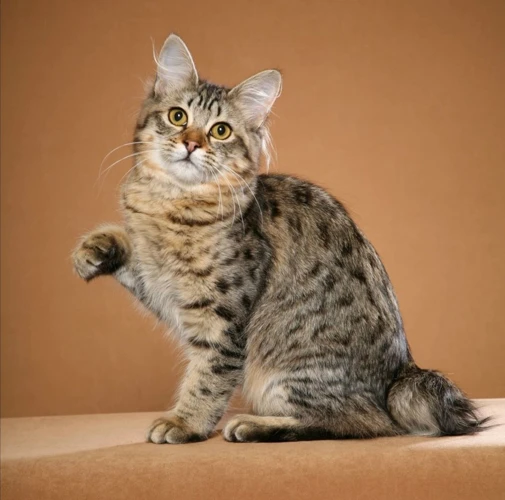
As we delve further into the history of American Bobtails, we must also explore their significance in the societies of the past. From working cats to sacred felines, American Bobtails have played various roles in different ancient cultures. Through their unique appearance and personality, they have earned a special place in history as both practical and symbolic beings. In this section, we will explore the different roles that these cats played in ancient societies and the impact they had on the people of their time.
American Bobtails as Working Cats:
The American Bobtail cats have been around for centuries and have been appreciated for their hunting and working abilities. These cats were often kept by farmers and ranchers to help control the rodent population on their properties. Their strong hunting instincts made them a valuable addition to the workforce in ancient times. These cats were also known for their ability to work alongside their human companions, often lending a helping paw in various tasks.
1. Effective Hunters: One of the primary reasons why American Bobtails were used as working cats was their exceptional hunting skills. Known for their agility and athleticism, these cats were great at catching rodents and other small prey without tiring easily. Their sharp senses and quick reflexes made them a valuable asset to farmers and ranchers in controlling the rodent population that could damage crops and food stores.
2. Expert Mousers: American Bobtails were specifically bred to hunt and capture rodents. They are natural-born mousers that can track, pounce on, and capture their prey with ease. Their hunting instincts were so finely tuned that they were often used to catch mice and rats on ships, preventing them from destroying the cargo and causing diseases.
3. Companion and Protector: Beyond their hunting abilities, American Bobtails were also valued by ancient people for their loyalty and companionship. They were known to follow their human companions around and were great at detecting danger. They could alert their owners to the presence of any intruders or potential predators, thereby serving as protectors of their territory and assets.
4. Assistance in Tasks: American Bobtails were known for their willingness to lend a helping paw in various tasks. They were great at keeping an eye on the household, running errands, and even helping to pull small loads like toys or tools. They were incredibly adaptable and could fit seamlessly into any work environment, making them an indispensable part of many ancient societies.
American Bobtails were highly valued as working cats for their hunting prowess, mousing abilities, and undying loyalty. They were used in various tasks and were often seen as protectors and companions by their human companions. These cats have a rich history in ancient cultures and continue to be appreciated for their working abilities in the modern world as well.
American Bobtails as Sacred Cats:
Throughout history, cats have been worshipped as sacred animals in various cultures. American Bobtails were no exception, as they were revered in many societies for their unique characteristics and personalities.
The table below highlights some of the cultures that worshipped American Bobtails as sacred cats, along with the specific traits that attributed to their divine status:
| Culture | Divine Traits |
|---|---|
| Egyptian | Mummified American Bobtails were found in tombs, indicating that they were believed to have a direct connection to the gods. Egyptian cat goddesses, such as Bastet and Sekhmet, were often depicted with American Bobtails by their side. |
| Japanese | American Bobtails were considered to bring good luck and fortune to their owners. They were often featured in Japanese artwork, such as woodblock prints, as symbols of prosperity. |
| Celtic | American Bobtails were associated with the goddess Brigid, who was also known as the patroness of cats. It was believed that American Bobtails had the ability to communicate with the spirit world and act as protectors. |
In addition to their divine status, American Bobtails were often given special treatment by their owners. In ancient Egypt, killing a cat was punishable by death, even if it was an accident. This was due to the belief that cats were sacred creatures that brought good luck and prosperity.
The sacred status of American Bobtails in ancient cultures highlights the reverence and respect that these cats have garnered throughout history. Whether as divine companions or protectors, American Bobtails have held a special place in the hearts of many societies around the world.
American Bobtails as Symbolic Cats:
In ancient cultures, American Bobtails were seen as more than just working or sacred cats. They also held symbolic significance in many societies. Here are some examples:
- Strength and Power: Because of their muscular build and hunting abilities, American Bobtails were often seen as symbols of strength and power. They were especially revered by warriors and hunters who admired their ability to take down prey.
- Protectors: In some cultures, American Bobtails were seen as protectors of the home and family. Their strong and loyal personalities made them ideal guard cats, and they were often tasked with keeping evil spirits or unwanted visitors away from the household.
- Independence and Freedom: American Bobtails are known for their independence, and this quality was often seen as symbolic of freedom in many cultures. They were admired for their ability to roam freely and live life on their own terms.
- Mystery and Magic: With their unique appearance and mysterious origins, American Bobtails were often associated with magic and the unknown. In some societies, they were seen as messengers to the spirit world or guardians of secret knowledge.
These symbolic meanings of American Bobtails varied from culture to culture, but they all reflect the unique qualities of this fascinating breed. Today, American Bobtails continue to be beloved pets and are admired for their intelligence, loyalty, and strength.
The Journey of American Bobtails to the New World
The perplexing journey of American Bobtails to the New World is shrouded in mystery and speculation. How exactly did these cats make their way from their ancient cultures to the shores of North America? Were they brought over by early settlers or did they arrive aboard ships as stowaways? In this section, we’ll explore the fascinating history of American Bobtails in North America and how they have evolved into the beloved pets we know today. Let’s delve deeper into the mysterious journey of American Bobtails to the New World.
American Bobtails in North America:
The American Bobtails arrived in North America along with the early settlers who traveled across the Bering Strait from Asia during the Ice Age. They were known for their hunting skills, and farmers and ranchers began using them to protect their crops and livestock from rodents and other pests.
Table: American Bobtails in North America
| Period | Significance |
|---|---|
| 17th – 18th century | American Bobtails were brought to America by early settlers and used as working cats on farms to keep rodents and other pests away from crops and livestock. |
| 19th century | American Bobtails were officially recognized as a breed by the Cat Fanciers’ Association in 1989. |
| 20th century | American Bobtails gained in popularity in the United States, and breeders began developing the breed further, leading to the creation of distinct traits such as the short, bobtail and muscular body. |
During the 19th century, the American Bobtails were recognized by the Cat Fanciers’ Association and eventually gained in popularity due to their unique appearance and friendly and affectionate nature. Breeders began to develop the breed further, leading to the creation of distinct traits such as short, bobtail, and muscular body.
Today, the American Bobtail is a beloved breed in North America and globally. They are known for their intelligence, playfulness, and loyalty to their owners. They have even been featured in advertisements, movies, and television shows, cementing their status as a cultural icon in North America.
American Bobtails in the Modern World:
After their journey to North America, American Bobtails made their way to the modern world, where they gained popularity among cat owners, enthusiasts, and breeders. The breed was officially recognized by The International Cat Association (TICA) in 1989. Since then, breeders have been breeding American Bobtails for their friendly temperament, unique appearance, and playful nature.
American Bobtails are currently among the most popular cat breeds in the United States. They are known for their short, stubby tails and their affectionate and playful personalities. They are also highly adaptable and can live in both rural and urban environments. Despite their popularity, American Bobtails are still considered a rare breed, with only a few thousand registered with TICA.
In recent years, American Bobtails have been used in crossbreeding programs with other breeds, resulting in several new hybrid breeds. For example, the American Bobtail was crossed with the Siamese to create the Si-Bob, a hybrid breed with a Siamese-like appearance and Bobtail personality.
Here is an overview of some of the characteristics of modern American Bobtails, as well as some facts about the breed:
| Characteristic | Details |
|---|---|
| Appearance | American Bobtails have short, bushy tails that are often curled or kinked. They come in a variety of colors and patterns, including tabby, calico, and solid colors. |
| Temperament | American Bobtails are friendly, affectionate, and playful cats. They are known for their intelligence and adaptability, and they get along well with children and other pets. |
| Health | American Bobtails are generally healthy cats, but they are prone to certain health issues, including hip dysplasia and heart disease. Regular veterinary checkups are recommended. |
| Grooming | American Bobtails have a medium-length, shaggy coat that requires regular grooming. Weekly brushing is recommended to keep their coats looking healthy and shiny. |
| Population | American Bobtails are still considered a rare breed, with only a few thousand registered with TICA. |
American Bobtails have become a beloved breed in the modern world, for their unique appearance and friendly personality. Their journey from ancient times to the present day is a testament to their resilience and adaptability, and they continue to capture the hearts of cat lovers around the world.
Conclusion
After a thorough exploration of the history of American Bobtails, it’s clear that these cats have a fascinating and mysterious past. From their debated origins to their roles in ancient societies, American Bobtails have left a lasting impact on the world throughout the centuries.
What’s particularly intriguing about these cats is the variety of ways in which they were valued in different cultures. We saw how they served as working cats in some societies, guarding grain stores and keeping rodents under control. In others, they held significant spiritual and cultural significance as sacred animals. And still, in other societies, they were viewed as simply aesthetic symbols.
Despite their lofty status in the past, American Bobtails have certainly held their own in the modern world. They’re beloved pets in homes just like any other domesticated cat, and their unique physical characteristics and friendly temperaments continue to endear them to their owners.
It’s clear that American Bobtails have come a long way since their ancient origins, and yet they still maintain an air of mystery. Perhaps it’s their striking physical appearance coupled with their storied history that makes these cats so intriguing. One thing is certain: American Bobtails have left an indelible mark on the world, and we’ll continue to appreciate and marvel at their presence for years to come.
Frequently Asked Questions
1. Can American Bobtails be trained to do tricks?
American Bobtails can be trained to do tricks with patience, positive reinforcement, and consistency. They are intelligent and enjoy learning new things.
2. Do American Bobtails make good indoor pets?
Yes, American Bobtails adapt well to indoor living and are happy as long as they have enough space to play and explore. They are also great with children and other pets.
3. Are American Bobtails prone to any health problems?
American Bobtails are generally healthy cats with a longer lifespan than many other breeds. However, they may be prone to hip dysplasia and kidney disease.
4. What is the typical personality of an American Bobtail?
American Bobtails are known for their friendly and outgoing personalities. They are playful and affectionate, and they enjoy being around people and other animals.
5. Do American Bobtails shed a lot?
American Bobtails have a thick, shaggy coat that requires regular grooming to prevent matting and tangling. They do shed, but not excessively.
6. Can American Bobtails be left alone for long periods of time?
American Bobtails don’t like to be alone for long periods of time and may become destructive or develop behavioral issues if left alone frequently. They prefer to be around people and other animals.
7. Are American Bobtails good mousers?
American Bobtails have strong hunting instincts and make excellent mousers. They are fast and agile, and they enjoy chasing and catching small prey.
8. How do American Bobtails communicate?
American Bobtails communicate with a variety of vocalizations, including meowing, purring, and chirping. They also use body language, such as tail wagging and ear position, to convey their feelings.
9. Do American Bobtails need a special diet?
American Bobtails don’t require a special diet, but they benefit from a high-quality, grain-free cat food that provides the nutrients they need to stay healthy and active.
10. Are American Bobtails lap cats?
American Bobtails enjoy being petted and cuddled, but they are not typically lap cats. They prefer to be near their humans rather than on them.

